Meet the robot cats, companions and AI tools transforming the way Singapore looks after seniors
As Singapore becomes a super-aged society and more seniors are expected to live alone, experts and eldercare providers say artificial intelligence and cutting-edge technology will be the way to go to manage the growing task of caring for the elderly and helping them live healthier for longer.
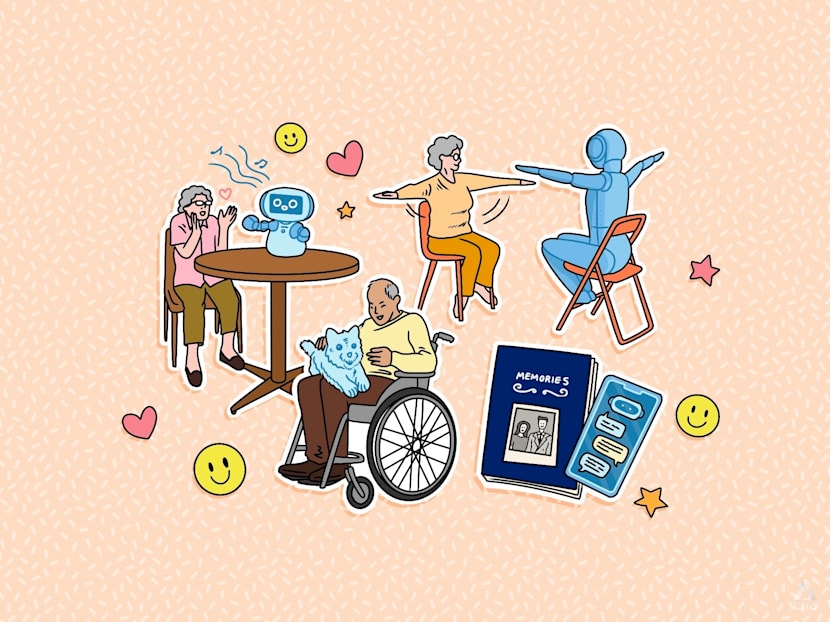
As Singapore edges toward a super-aged society, experts say the real promise of using technology and AI in eldercare lies in preventing health problems. (Illustration: ¬ť∂Ļ/Nurjannah Suhaimi)

This audio is generated by an AI tool.
It's a Thursday morning at the Lions Home for the Elders, and a chorus of English, Mandarin and Malay classics fills the common area as a group of seniors gather for karaoke. There is a familiar face leading the singalong ‚Äď and it is not a polyglot staff member, but Dexie, a humanoid robot.
Since joining the home in 2023, Dexie has been a "hardworking employee" who guides residents through daily physiotherapy exercises, karaoke sessions and weekly games of bingo.
Around the homes located in both Bishan and Bedok, she is part of a growing cast of artificial intelligence (AI) -powered technology helping to keep more than 300 residents active and engaged.
Nearby, a smaller robot named Kebbi shuffles to its own beat, occasionally pausing to pose riddles to seniors or flash localised picture trivia games on its screen.
One long-time resident, Madam Tan Siew Lin, is cradling a fluffy baby seal, calling it "sayang".
The 77-year-old is aware that her cuddly companion, Paro, is a therapeutic robot from Japan that responds to touch with lifelike sounds and blinking eyes.
But to Mdm Tan, the suite of robotic pets at the eldercare facility remind her of the pet she once had.
"They're all very cute. The big one can teach me to exercise, teach us singing and play bingo for us, it's like a very nice friend. The small robots can listen to you, teach dancing ‚Äď you can learn so many things."


At eldercare facilities and active ageing centres across Singapore, technology is no longer a novelty, but already beginning to change how seniors connect, heal and age.
At St Luke's ElderCare Active Ageing Centre (Care) @ Northshore, for example, 66-year-old Albert Yeo got to realise his dream of writing a book documenting his life as part of the pilot Golden Memories programme, where seniors used generative AI to put together a story of their life's milestones.
"This is my first time I've touched AI, but I feel the AI is helping a lot. Even if we are not very clear about the message or grammar, (the programme) settles it for you," said Mr Yeo.
To write the book, he had verbal conversations with an AI chatbot in an app on his phone which prompted him to reflect deeply about his childhood, his business and his love for hiking.
It then generated the text for the 45-page book, which Mr Yeo has since printed out and shared with family and friends, many of whom have requested their own copies.
As Singapore hurtles towards becoming a ‚Äď with more than one in five here expected to be 65 years old or older by 2026 ‚Äď such tools are offering relief for some eldercare providers.
Machines can lead group activities, provide companionship, or help track residents' health and moods. And as the population of seniors living alone is expected to rise, trials are underway to use technology to support seniors ageing in place.
As Dr Kelvin Tan, head of the minor in Applied Ageing Studies programme at the Singapore University of Social Sciences (SUSS), put it, one of the challenges that the country is facing is a lack of manpower to support the ageing population, so technology is very important to complement and support this growing need.
"Singapore will have no choice. We need to embrace AI. This is not just a buzzword, but an important development that we need to tap on," he said. "When we are able to synergise AI in the healthcare setting, I'm sure we can reduce the burnout, the anxiety of carers and provide a good quality of care".
At the national level, HealthTech agency Synapxe is using AI and machine learning to improve healthcare delivery, accessibility and patient outcomes, said Mr Andy Ta, its chief data officer and director of data aNalytics and AI (DNA).
Its HealthHub AI project ‚Äď a multilingual conversational assistant which supports English, Chinese, Malay and Tamil ‚Äď allows users to ask health questions through voice or text and receive answers sourced from the HealthHub website.
Still, experts say the challenge lies in balance ‚Äď ensuring that technology enhances, rather than replaces, the empathy, trust and human touch needed for good eldercare.

REDUCING ISOLATION, CAREGIVER LOAD
The ways AI and technology are used in the eldercare sector vary widely, but the goal is generally simple: to free up caregivers for more meaningful interactions with seniors while digital tools handle routine, labour-intensive work.
In response to ¬ť∂Ļ TODAY's queries, chief executive officer of the Agency for Integrated Care (AIC) Tan Chee Wee said that AI and technology are currently in use to automate routine tasks such as scheduling, the generating and updating of case notes and sending medication reminders.
Mr Tan Chee Wee pointed to a range of existing solutions that support Singapore's eldercare sector: At Active Ageing Centres, touchscreen games are being used to improve cognitive function, while robotic pets provide emotional support and check-in devices let seniors indicate they are safe with a button press, allowing for a more efficient distribution of resources to those who might need them more.
One example is AWWA’s dementia daycare centre, which uses an interactive screen system that lets its average of 45 daily clients select preferred activities.
"Clients enjoy the autonomy of choosing their own activities, which supports engagement and participation," said Ms Stella Phua, who oversees health and senior care at AWWA.
"Staff have shared that the system improves workflow efficiency and reduces manual tasks, allowing them to focus more on meaningful interactions with clients."
AWWA also uses technology to enhance seniors' physical rehabilitation, with the Ekso exoskeleton, a wearable, powered device supporting gait training for clients with mobility challenges, including those recovering from stroke or neurological conditions.
"Robotic and AI-assisted tools can provide objective data such as step count, step length, and gait quality, along with real-time feedback during ambulation. They also support high-intensity, high-repetition training within a shorter period," said AWWA's senior physiotherapist Phyo Ei Khin.
Beyond physical recovery, technology is being used to manage seniors’ emotional well-being, by addressing loneliness, anxiety and early cognitive decline.
At Lions Home for the Elders, rehabilitation manager Pratiti Kaji said residents were initially apprehensive when robots such as Dexie were introduced, but many have grown comfortable or even more responsive to robot-led exercises than to staff.
Ms Prudence Chan, the home's consultant occupational therapist and dementia care specialist, said robotic pets also help calm residents with advanced dementia and combat senior isolation.
"For advanced patients, sometimes they have difficulty finding words. But we have observed when we pass them a robotic pet, we see them seeking initiative to cuddle, kiss, hug it, and this is already a positive engagement," said Ms Chan.
Ms Pratiti added: "The residents are aware that they are robots. Even then, they make an attachment with them. We used to have pet therapy, but we cannot have that often, and there are also some hygiene issues."
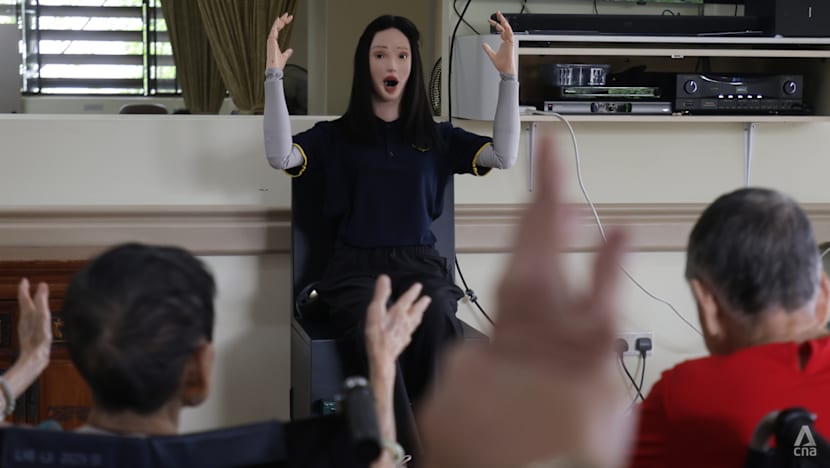
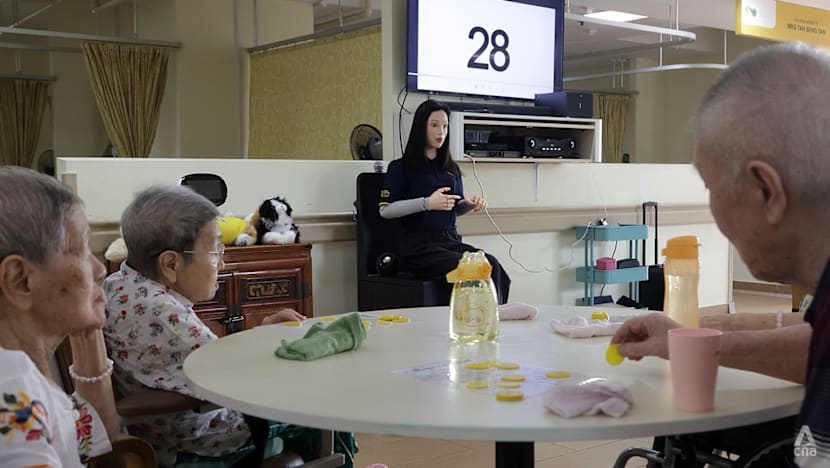
At St Luke‚Äôs ElderCare, the Golden Memories programme has seen more than 250 elders across its Active Ageing Centres use generative-AI ‚Äúreminiscence therapy‚ÄĚ to help them celebrate their life journeys, with plans to expand the initiative to more centres and nursing homes.
Adjunct Associate Professor Kenny Tan, the organisation‚Äôs CEO, pointed also to the Virtual World programme, where more than 2,500 virtual reality (VR) sessions have allowed more than 440 seniors to ‚Äútravel‚ÄĚ the world.
"It brings immersive travel and social experiences to elders, especially those facing physical disabilities and isolation," said Assoc Prof Kenny Tan, who said a joint study with SUSS showed that elders felt happier and less lonely after the programme.
At Lions Befrienders, there is a suite of LB TechCare programmes that use AI to monitor and support seniors’ mental and cognitive health, some of which are being used across its 10 Active Ageing Centres, while others are home-based solutions that seniors are trained to use independently.
The IM-HAPPY programme analyses facial expressions in real time to detect early signs of distress using a camera on a laptop or tablet during home visits, while IM-ALERT screens for mild cognitive impairment and dementia through interactive tasks when seniors use an application on a tablet. Data is then reviewed by staff who step in with human-led interventions when needed.
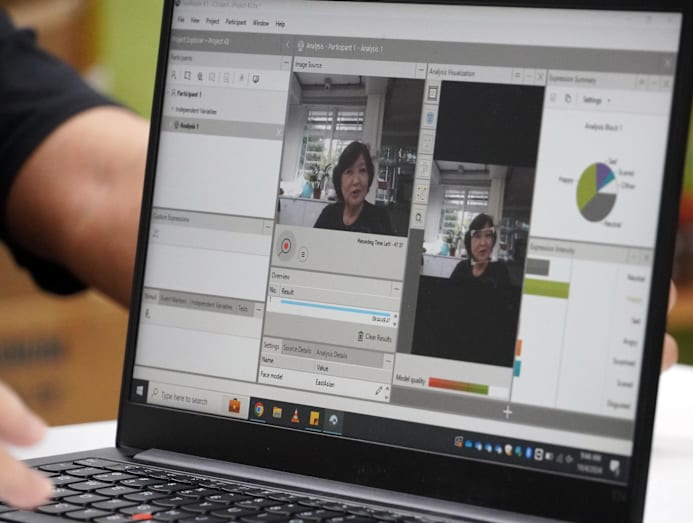
More recently, the charity launched a voice-based AI agent that automates check-in calls to seniors living alone, increasing the number of touchpoints while easing staff workload.
Developed in partnership with Seasalt.ai and Twilio, the system has a conversational style, and recognises Singlish and emotional cues to respond empathetically.
"For the seniors, the biggest outcome is a sense of being remembered and heard, with one senior noting that the voice AI gave them warmth and made them feel like they were not forgotten," said Ms Karen Wee, executive director of Lions Befrienders.
At Bishan Home for the Intellectually Disabled, researchers from the Singapore University of Technology and Design (SUTD) are developing AMI Intelli, an AI-powered system which estimates each resident’s cognitive and socio-emotional state through how they play and interact with a game platform and conversational agent.
‚ÄúThe model looks at patterns such as how accurately and quickly a person completes different game types, how much support they need, and how their performance changes over time,‚ÄĚ said Professor Yow Wei Quin, professor of Psychology and head of the Humanities, Arts, and Social Sciences cluster at SUTD.
These patterns and other indicators of mood or interest are mapped to familiar clinical domains using machine-learning models, which regularly update to give care staff trend-based insights.
Its underlying technology, said Prof Yow, could later support community seniors and people living with dementia.
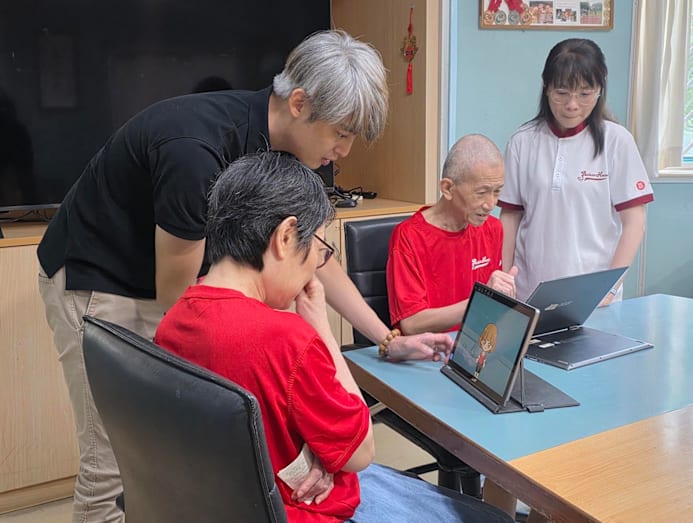
THE FUTURE OF ELDERCARE
All this is just the beginning. As Singapore edges toward a super-aged society, experts say the real promise of using technology and AI in eldercare lies in preventing health problems before they escalate and in moving care closer to where seniors live.
Professor Joseph Sung, dean of the Lee Kong Chian School of Medicine and head of Nanyang Technological University's (NTU) Centre of AI in Medicine, said AI could be the "first line of contact" for seniors.
"AI, using a chatbot or even avatar, can talk to patients, understand or have some idea how urgent the problem is, so that he or she may be referred to a family doctor nearby instead of coming to hospital and waiting for hours, or be reassured that they can observe (their condition) for a little while at home," said Prof Sung.
The Centre of AI in Medicine, he added, is studying how AI and technology can help seniors live more healthy lifestyles and prevent disease, and be cared for at home instead of the hospital.
And while some solutions are still on the horizon, their potential applications are already being studied in labs, clinics and care centres across Singapore.
At SUTD, Professor Low Hong Yee and her team are creating Neatsens, a line of smart knitted garments that double as motion trackers. As the wearer walks, bends, or stretches, the fabric generates small electrical signals that are collected and then translated into movement data.
The first prototype, a smart knee brace, captures step count, gait symmetry and key mobility indicators such as the Sit-to-Stand test. A trial with 25 seniors at Eunos Polyclinic showed encouraging results, and a larger validation study is planned ahead of a targeted 2027 public launch.
Prof Low, who is head of the engineering product development pillar at SUTD, said the goal is to give physiotherapists and caregivers objective data after discharge, when most rehabilitation actually occurs, rather than snapshots of mobility progress during clinic visits.
"Singapore’s rehabilitation demand is rising sharply due to rapid population ageing, higher chronic disease burden, and increasing post-acute functional impairment. Yet real-world functional data remains largely invisible to healthcare providers," said Prof Low.

Improving eldercare at home is also the focus of local startup SoundEye, which builds technologies that detect falls, unsafe movements and distress calls without cameras or wearable devices.
Dr Tan Yeow Kee, SoundEye's CEO, said its current system Lasso uses low-resolution depth imaging to detect the resident's body posture and sends immediate alerts to caregivers after detecting screaming or calls for help using sound-recognition AI.
An upcoming smart ceiling light AURI, which will be launched in 2026, will automatically turn on the lights when it detects a person moving and can scan an entire room for unusual movements and sounds. It will also send a notification to caregivers on a mobile app with a short video clip, should an alert be triggered.
Complementing these efforts to keep seniors safe at home, researchers from Sengkang General Hospital (SKH) and Singapore Management University (SMU) are tracking how subtle changes in day-to-day routines may reveal the first signs of decline.
Their Sensors In-home for Elder Well-being (Sinew) project has placed discreet in-home sensors that track mobility, sleep patterns, activity levels, use of home spaces and medication-related routines for more than 200 participants. The data is then analysed by machine-learning models trained to detect subtle changes linked to mild cognitive impairment.
It has so far demonstrated about 90 per cent accuracy in identifying seniors at higher risk of cognitive impairment.
“Early cognitive or functional changes often manifest as small behavioural shifts that are not easily detected during short clinic visits yet yield rich information that clinicians will need on an individual’s change over time," said Associate Professor Iris Rawtaer, head of psychiatry and director of research at SKH, and SMU Professor of Computer Science Tan Ah Hwee in a written response.
Future phases will integrate these insights into outpatient memory clinics and primary care, and expand into community-care settings as part of a case-finding strategy for older adults living alone and the general public, given that much of health prevention efforts ideally begin in midlife.
Some innovations are also supporting seniors by aiming to ease the burden of healthcare professionals. SeniorSync, a request-management platform built by a team of information systems students from SMU, uses an AI-driven smart-assignment tool to prioritise tasks by urgency and staff workload for staff at Active Ageing Centres.
"Many centres still rely heavily on manual processes and paper-based workflows, which slow down operations and take time away from building meaningful relationships with senior," said co-founder Tan Ee Herng.
Supported by the GovTech Build for Good Accelerator 2025, the team is now in talks with eldercare operators for a potential rollout planned for the second half of 2026.
Associate Professor Donny Soh, programme lead of the Bachelor of Science with Honours in applied artificial intelligence at the Singapore Institute of Technology (SIT) said the true potential of AI lies in empowering older adults to age well, age in place and maintain genuine independence.
"While this vision may feel aspirational now, the rapid pace of innovation suggests it will become achievable within the next four to five years," said Assoc Prof Soh.
CAN SINGAPORE ACCEPT ELDERTECH?
For all the up-and-coming eldercare technology in Singapore's market, experts said current infrastructure and adoption trails behind countries like Japan ‚Äď home to innovations like Paro the therapeutic robot seal since the early 2000s ‚Äď which has long grappled with the realities of a super-aged society.
They also raised the question of whether elderly Singaporeans are ready to embrace even more technological tools, some of which can feel complicated or invasive. They also tend to be costly.
Dr Kelvin Tan from SUSS noted that companion robots have to be designed to be appealing to seniors ‚Äď with some newer machines like the Japanese Lovot robot even being designed to have a body temperature of 37 degrees Celcius ‚Äď to avoid the sense of "uncanny valley", or robots having a frightening appearance in their attempt to be lifelike.
The successful adoption also often depends on the support of families and caregivers around seniors and their willingness to make small adjustments to daily routines ‚Äď especially for devices installed in homes.
Through Soundeye's Lasso trial deployment under the HDB Enhancement for Active Seniors (EASE) programme, several challenges surfaced: wall-mounted installations required extra wiring and trunking, which some residents found unsightly, while the sensors using a power outlet gave some families the impression that the device is consuming extra energy.
In some cases, residents accidentally switched off the power, disrupting monitoring and reducing reliability, though Dr Tan Yeow Kee of SoundEye added that their new design AURI will address the above feedback.
He added that another difficulty is next-of-kin response time, as family members may be asleep, in meetings or overseas when alerts come in.
"In one case back in 2023, an elderly person suddenly fell in the kitchen while using the sink. We quickly contacted the next of kin, but they were on vacation," said Dr Tan Yeow Kee.
While the team reached out to other family members, the elderly person remained on the floor for about an hour before being taken to the hospital and fortunately recovered.
Experts cautioned that this shift must be handled delicately to ensure such solutions remain accessible to the seniors they are meant to benefit.
"The challenge of technology (in eldercare) today is while it is happening and accelerating very fast, the cost itself can be huge and prohibitive to the consumer level or even organisations, because you are still using old infrastructure," said Dr Kelvin Tan from SUSS.
Social companion robots such as Paro can cost several thousand dollars, while advanced units like Dexie are priced at over S$150,000.

Even individual AI-powered products already on the market, largely imported from East Asia, can range from S$600 to S$8,000 per unit, noted Dr Kelvin Tan.
"As an individual requiring a companion, you'll find that, 'Wow, this is expensive for me.' But if we look at it as an investment in a setting like an Active Ageing Centre or nursing home, it can be shared among a couple of people, then the cost may go down. So we need to address how costs can become more appealing with different business models."
Pricing and providing value for the Singaporean market is also on the mind of SoundEye's Dr Tan Yeow Kee, who noted that lower-cost solutions such as panic buttons or simple fall-detection cameras may not adequately address seniors’ needs.
But designing a more comprehensive solution also requires a rethink of feasible business models. His company's products will ideally include support from a 24-hour call centre that can respond quickly to alerts, and an operations centre staffed by part-time caregivers who annotate data and improve the AI system over time.
"The central question is: Who will fund AI solutions to support older adults? Delving deeper, we must ask how much society is prepared to invest in individuals nearing the end of their lives," said Dr Tan Yeow Kee.
For now, SoundEye's focus remains on business-to-business models and community partnerships rather than direct consumer sales.
Beyond cost, experts noted that privacy and cultural acceptance will shape how technology takes root in the eldercare landscape. With swaths of personal data collected from sensors and wearables, questions around data protection loom large.
For solutions like SoundEye’s monitoring system and the Sinew project, privacy has been designed into the system to help seniors stay safe without being intrusive.
Dr Tan Yeow Kee from SoundEye said its current system, Lasso, uses low-resolution depth imaging to classify body postures ‚Äď such as sitting, standing, attempting to get out of bed, slumping or falling ‚Äď ensuring ‚Äúfull privacy‚ÄĚ even in bedrooms and washrooms.
Assoc Prof Rawtaer and Prof Tan Ah Wee who are leading the Sinew study said they received "clear feedback" from seniors about privacy boundaries.
As such, the system avoids cameras, audio collection, or personally identifiable video and is designed to centre strictly on anonymous activity data.
Incorporating AI in eldercare must also account for high levels of cultural sensitivity, said SIT's Assoc Prof Soh, as its success in providing cognitive or emotional support depends on understanding local dialects, cultural idioms or social hierarchies where respect for the elderly is paramount.
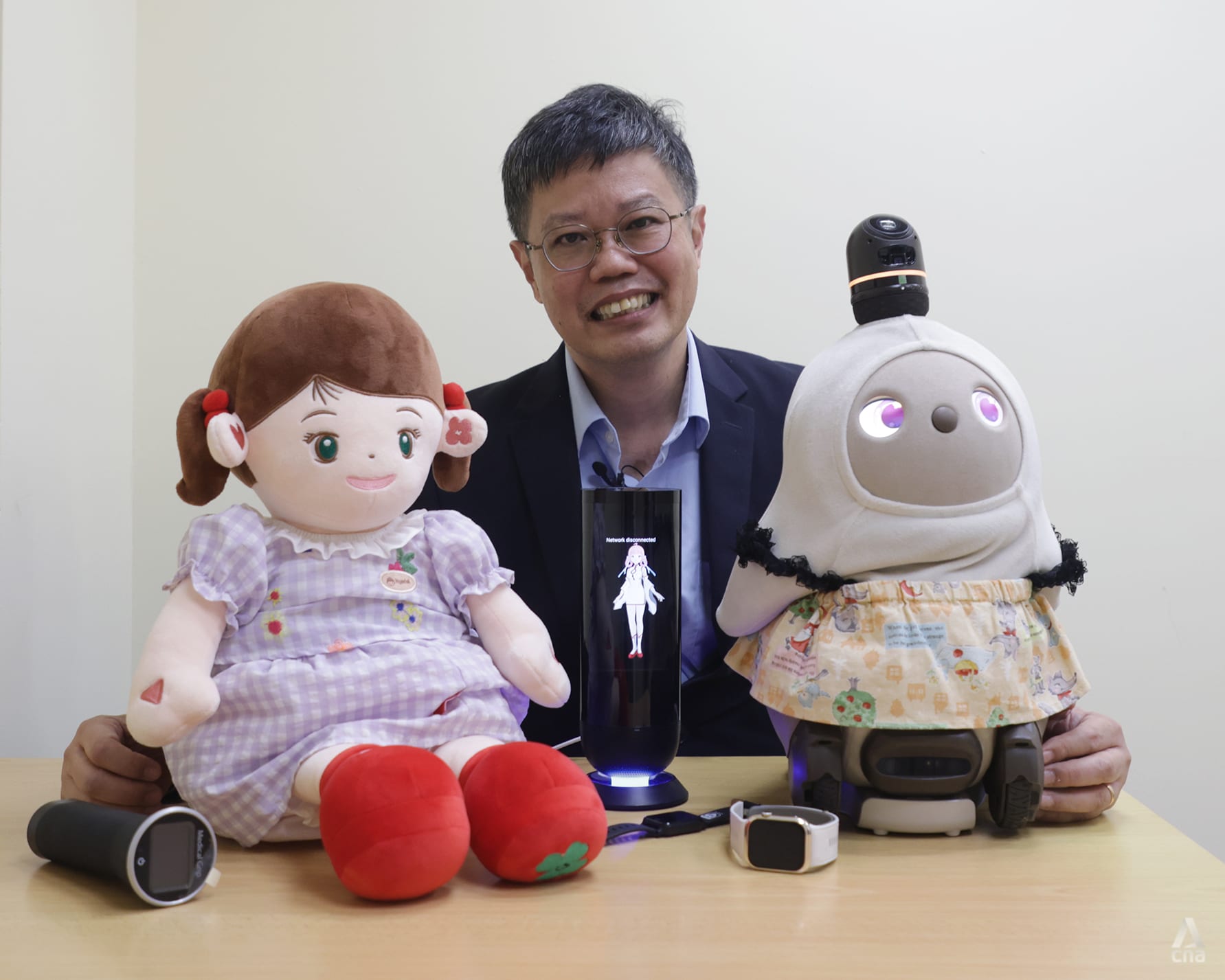
BLENDING EMPATHY AND INNOVATION
As AI and smart systems become more common in eldercare, experts said there is still much to understand about how technology can work alongside human caregivers.
Prof Sung from NTU’s Centre for AI in Medicine said one challenge is making sure healthcare professionals buy in and trust these technologies and learn how to use the data technology provides to improve eldercare systems.
With many wearable health devices already widely available, data collection is not the issue, but the task now is for scientists and clinicians to catch up with how to interpret the vast amount of information AI and technology makes possible.
"For example, if I measure your blood pressure once per day, I only have one reading to judge whether this person requires antihypertensive medicine. If I am wearing a device that gives you 24-hour blood pressure monitoring, then you will need to have a new way of interpreting the data," said Prof Sung.
"AI is going to revolutionise healthcare very quickly in the next five to 10 years. Healthcare providers have to learn how to prepare ourselves for rapidly changing healthcare services, and we need to educate the public on what AI and digital tools can do, and reassure them that these are used responsibly".
Singapore is making strong inroads in adopting AI in eldercare to assist staff and manage facility logistics, but Assoc Prof Soh from SIT said the next frontier is dealing with hurdles in technology maturity, infrastructure and privacy when it comes to supporting elderly independence.
"Take assistive mobility devices for example: They restore independence, giving an elderly person greater control over their ageing process. But this independence also carries risks ‚Äď fire hazards, safety concerns, and the more subtle risk of over-dependence, which can lead to the gradual loss of essential life skills," he added.
Eldercare operators said navigating the balance between adopting AI-powered solutions and maintaining empathetic, person-centred care remains vital.
Mr Tan Chee Wee, the CEO of AIC, said that rather than replacing the human touch, AI and technology should support the work of community care professionals in providing better care and support to seniors.
"Ultimately, AI and technology must safeguard the human core of care. Responsible adoption is key, which can be achieved by co-designing such solutions with seniors, caregivers, and providers, while protecting privacy and improving digital literacy."
After all, incorporating technology such as robotics or generative AI for seniors also comes with a learning curve ‚Äď for caregivers as much as for seniors.
For the team of students from SMU that built the request management system SeniorSync, one of the biggest challenges while testing their system was the fear of change among staff.
"In the eldercare sector, many staff members are older themselves and may not be as comfortable with technology. This means that even small shifts in workflow can feel overwhelming or intimidating," said Mr Tan Ee Herng from SeniorSync.
To make their tool even more accessible, he said the team is working on a mobile-friendly interface to support on-the-go usage.
For seniors like Mr Yeo, who attended the St Luke's ElderCare Golden Memories programme, becoming the proud author of a book was as much a result of the AI programme's prompting as the effort of patient trainers who guided him along.
"The teacher was telling us it's very simple to manage, but because we are elderly, we're very afraid of all this," said Mr Yeo.
Staff and volunteers guided seniors on how to load the app and chat with the AI and through the programme, Mr Yeo learnt new facts about his wife, who also participated in the programme.
Mr Yeo has gained confidence in his own tech savviness and now encourages other seniors to give technology and AI tools a chance.
"It's not easy for the elderly, but it's really good to try," said Mr Yeo.
"I'm very grateful. I'm telling myself, I got a grandson, granddaughter. So next time, I got something to pass them. They'll know gong gong's story."












